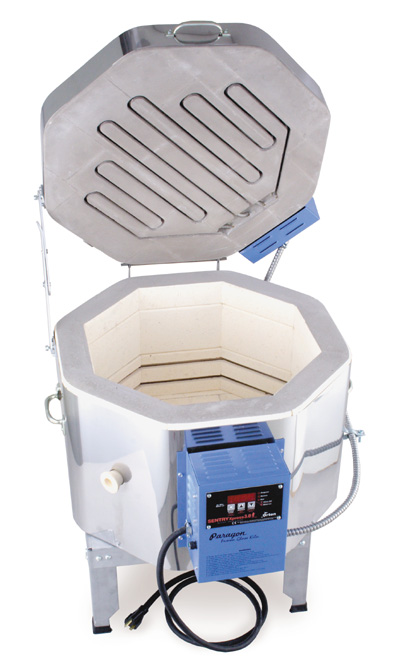 |
|
|
Kiln Pointers
|
|
|
Analyzing the Cracks in a Firebrick Bottom |
CONTENTS Analyzing the Cracks in a Firebrick Bottom Reader Response: Leveling a kiln with a bowl of water; posts in the bottom of a kiln; a kiln adventure Recent Q&As: Firing a 208 volt kiln on 240 volts; how to fire a ceramic kiln to a temperature instead of a cone Memorable Quote ----------- ANALYZING THE CRACKS IN A FIREBRICK BOTTOM Cracks in the firebrick floor are natural and inevitable. Minor cracks are usually nothing to be concerned about. As the firebricks expand during firing, the cracks close. A kiln does not lose heat through minor cracks in the firebrick bottom, so repairs are usually unnecessary. The cracks should not extend straight down to the galvanized base plate, however. And the base plate must be in good condition. Examine the base plate with a mirror and flashlight. If the steel is falling apart with rust, you should replace it. The easiest way is to slide a piece of galvanized sheet metal between the kiln bottom and the kiln stand. You can slide it right under the old base plate. Make sure the kiln stand is solid, level, and sturdy. If the kiln wobbles, the stress of weight from ware inside the kiln can crack the floor. The stand must also support the walls of the kiln. A small stand that doesn’t extend out to the walls will exert too much pressure against the inner area of the firebrick bottom. This will cause the bottom to crack. If you use silica sand on the kiln shelves, be careful not to allow the sand to seep onto the firebrick bottom. The sand will get into the cracks and widen them. ----------- READER RESPONSE The last Kiln Pointer was on leveling a kiln. Joe Spitzer, the “Kiln Doctor” of Central Florida, wrote, “When I taught kiln seminars, I discussed the leveling issue and demonstrated leveling by using a clear bowl of water with a pattern line on it. Often my students didn't have levels. By adjusting the leveling as you alluded to, they could see if the water were level on the line around the bowl. I sometimes had fun coloring the water so it was easier to see. This relieved many of the mostly women from worrying about a ‘level.’” Two Kiln Pointers ago, I suggested placing a shelf on 1” or 2” posts in the bottom of a tall kiln for easier loading. Marty Cooper of Cary, North Carolina wrote, “Arnold, regarding leaving a shelf in the bottom of the kiln: I drove many hours to purchase a well cared for Duncan kiln. Unfortunately, I moved it with the shelf in the kiln on 1" posts. The shelf cleanly broke all the kiln element brick retainer sections. If you use this method, please remove the shelf before moving kiln.” Marty recently sent an email to clarify the details in her story. She wrote, “A family member of the kiln owner moved the kiln with kiln furniture inside. Upon our arrival to buy the kiln, we discovered this error. Had it not been for a substantial number of kiln shelves as part of the trade, we would have gone home empty handed. The kiln furniture made up for any damage the bricks had suffered.” John Schwartz wrote, “My wife is not happy about my kiln even though she bought it for me, because I spend all my spare time forming clay and firing my wonderful kiln. It truly is a creative adventure for me. My latest trick is to raku glass.” ----------- RECENT Q&As Q. We have two Duncan EA-1029 Pro Plus kilns; one is 208 volts and the other is 240 volts. I have 240 volt service. What problem may I encounter by firing these kilns on 240 volts? I have not yet fired the 208 volt. It is a spare. A. A 208 volt kiln fired on a 240 volt circuit will pull too much amperage. You should order new elements for the 208 volt kiln before firing it on the 240 volt circuit. When ordering the elements, please tell the customer service person that you need the parts to convert a 208 volt kiln to 240 volts. Q. The ceramic kilns in your catalog are fired to pyrometric cones. I have no experience with cones. Can these kilns also be programmed to temperatures? A. Digital kilns that fire to pyrometric cones use the controller's Cone-Fire mode. Paragon Sentry controllers that have Cone-Fire mode also have Ramp-Hold mode. In Ramp-Hold, program the temperature that is needed for each step of the firing. You can program temperatures for heating and controlled cooling. ----------- MEMORABLE QUOTE “It is no use saying, 'We are doing our best.' You have got to succeed in doing what is necessary.”--Winston Churchill ----------- My daughter-in-law, Leni, is studying to be a nurse. Last night she opened her big, tightly packed canvas medical bag and pulled out a stethoscope and blood pressure cuff. She practiced taking our blood pressures, and she checked the heart rate of Cius, one of the cats. I have met a number of nurses who owned kilns. Nurses are some of the kindest people I have known. Thank you, With best wishes, Arnold Howard Paragon Industries, L.P. – Better Designed Kilns 2011 South Town East Blvd., Mesquite, Texas 75149-1122 Voice: 972-288-7557 & 800-876-4328 / Fax: 972-222-0646 / ahoward@paragonweb.com / www.paragonweb.com / www.facebook.com/paragonkilns PRIVACY NOTICE: Under no circumstance do we share or sell your email address. Copyright 2013, by Paragon Industries, L.P. |
|
|

|
|
|
|
|
“Custom and standard Kilns and Industrial Furnaces for ceramics, pottery, heat treating, enameling, |
||||
